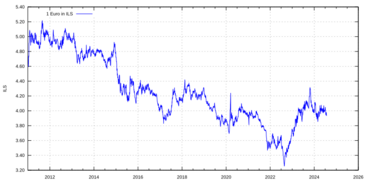Israeli new shekel facts for kids
Quick facts for kids Israeli new shekel |
|
|---|---|
| ISO 4217 Code | ILS |
| Official user(s) | |
| Unofficial user(s) | |
| Inflation | ▼−0.59% (2020) ▲0.35% (2021 est.) |
| Source | Bank of Israel, Statista, April 2021 |
| Subunit | |
| 1⁄100 | agora |
| Symbol | ₪ |
| Plural |
|
| agora |
|
| Coins | 10 agorot, ₪1⁄2, ₪1, ₪2, ₪5, ₪10 |
| Banknotes | ₪20, ₪50, ₪100, ₪200 |
| Printer | Orell Füssli |
The New Israeli Shekel (NIS) is the money used in Israel. It is also used in the Palestinian territories like the West Bank and the Gaza Strip. The New Shekel is divided into 100 smaller units called agorot.
This currency has been used since January 1, 1986. It replaced the Old Shekel, which had lost a lot of its value due to very high inflation. One New Shekel was worth 1,000 Old Shekels.
The symbol for the New Shekel is ₪. This symbol combines the first Hebrew letters of the words shekel (ש) and ẖadash (ח), which means "new." If the symbol isn't available, people often use the abbreviation "NIS."
History of Israeli Money
The Ancient Shekel
The name "shekel" comes from an old Biblical currency. For example, in the Bible, Abraham paid "four hundred shekels of silver" for land. A shekel was originally a unit of weight, meaning "to weigh" in ancient languages. In ancient Israel, one shekel was about 11 grams (or 0.35 troy ounces).
Israeli Pound (1952–1980)
When the modern State of Israel was formed in 1948, they first used the Palestine pound. In 1952, this currency was renamed the Israeli pound. At first, it was linked to the British pound.
In 1955, the Bank of Israel took over printing money. The Israeli pound was divided into 100 agorot from 1960. People debated the name "lira" (pound) because it wasn't a Hebrew word. So, a law was passed to change the currency name to "shekel." This change happened in February 1980.
Old Shekel (1980–1985)
The first "shekel," now called the Old Shekel, was used from 1980 to 1985. Both the Israeli pound and the Old Shekel often lost value compared to other currencies. In the early 1980s, the Old Shekel faced hyperinflation, meaning prices rose incredibly fast.
To fix this, the government introduced the New Shekel on January 1, 1986. One New Shekel was worth 1,000 Old Shekels.
The New Shekel Today (1985–present)
Since the New Shekel was introduced in 1985, the Bank of Israel has managed the economy carefully. They made changes that helped Israel's economy grow stronger. The country also signed free trade agreements, which made its economy more competitive.
Israel invested a lot in its industries and science. This helped the country export more goods and services. As a result, inflation has been low, and the New Shekel has become stronger. Between 2001 and 2011, its value increased by about 20% against the US dollar.
Since 2003, the New Shekel can be freely exchanged for other currencies around the world. You can even trade New Shekel derivatives on the Chicago Mercantile Exchange. This makes it one of only about 20 world currencies with widely available trading options.
Israeli Coins
In 1985, new coins were introduced for the New Shekel. These included 1 agora, 5 agorot, 10 agorot, ₪0.5 (half a shekel), and ₪1. Later, ₪5 coins came out in 1990, and ₪10 coins in 1995.
The 1 agora coin stopped being made in 1990 and was removed from use in 1991. A ₪2 coin was added in 2007. The 5 agorot coin was last made in 2007 and removed from circulation in 2008.
In 2011, the Bank of Israel considered making new coins that would cost less to produce and be harder to copy. They also thought about removing the word "new" from the coins. The coins are made by the Korea Minting and Security Printing Corporation (KOMSCO).
In 2022, the Bank of Israel announced updated inscriptions for its coins. The 5 and 10 new shekel coins will be the first to feature the new inscriptions. The 10 agorot and ₪0.5 new shekel coins will also have their unit names in Arabic.
| Image | Value | Technical parameters | Description | Date of | ||||||
|---|---|---|---|---|---|---|---|---|---|---|
| Diameter | Thickness | Mass | Composition | Edge | Obverse | Reverse | issue | withdrawal | ||
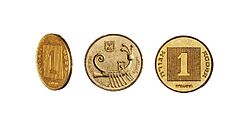 |
1 agora | 17 mm | 1.2 mm | 2 g | Aluminium bronze 92% copper 6% aluminium 2% nickel |
Plain | Ancient galley, "Israel" in Hebrew, Arabic and English | Value, date | 4 September 1985 | 1 April 1991 |
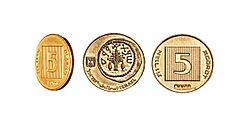 |
5 agorot | 19.5 mm | 1.3 mm | 3 g | Replica of a coin from the fourth year of the war of the Jews against Rome depicting a lulav between two etrogim, "Israel" in Hebrew, Arabic and English | 1 January 2008 | ||||
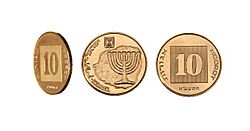 |
10 agorot | 22 mm | 1.5 mm | 4 g | Replica of a coin issued by Antigonus II Mattathias with the seven-branched candelabrum, the state emblem, "Israel" in Hebrew, Arabic and English | Current | ||||
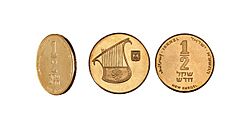 |
₪0.5 | 26 mm | 1.6 mm | 6.5 g | Lyre | Value, date, "Israel" in Hebrew, Arabic and English | ||||
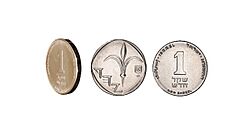 |
₪1 | 18 mm | 1.8 mm | 3.5 g | Cupronickel 75% copper 25% nickel (1985–1993) Nickel-plated steel (1994–present) |
Plain | Lily, "Yehud" in ancient Hebrew | Value, date, "Israel" in Hebrew, Arabic and English | 4 September 1985 | Current |
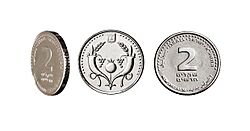 |
₪2 | 21.6 mm | 2.3 mm | 5.7 g | Nickel-plated steel | Segmented (plain and reeded sections) | Two cornucopia | 9 December 2007 | ||
 |
₪5 | 24 mm | 2.4 mm | 8.2 g | Cupronickel 75% copper 25% nickel |
12 sides | Capital of column | 2 January 1990 | ||
 |
₪10 | 23 mm Core: 16 mm |
2.2 mm | 7 g | Ring: nickel-bonded steel Center: aureate-bonded bronze |
Reeded | Palm tree with seven leaves and two baskets with dates, the words "for the redemption of Zion" in ancient and modern Hebrew alphabet | 7 February 1995 | ||
| For table standards, see the coin specification table. | ||||||||||
- Remember that all dates on Israeli coins are written in the Hebrew calendar using Hebrew numerals.
Israeli Banknotes
First Series of Banknotes (1985–1999)
The first New Shekel banknotes were released starting in September 1985. They came in values of ₪5, ₪10, and ₪50. A ₪1 note followed in 1986, and a ₪100 note later that year. The ₪20 note was issued in 1988, and the ₪200 note in 1992.
The ₪1, ₪5, and ₪10 notes were later replaced by coins. Some of these first coins even had the pictures of the people from the banknotes on them.
| Image | Value | Dimensions | Colour | Obverse | Reverse | Date of issue | Date of withdrawal |
|---|---|---|---|---|---|---|---|
 |
₪1 | 76x 138 mm | green | Maimonides | Tiberias where Maimonides is buried; ancient stone lamp | 8 May 1986 | 1995 |
 |
₪5 | blue | Levi Eshkol | Pipe carrying water, symbolizing the National Water Carrier, fields and barren land in background | 4 September 1985 | 1995 | |
 |
₪10 | orange | Golda Meir | Picture of Golda Meir in the crowd, in front of the Moscow Choral Synagogue, as she arrived in Moscow as Israel's ambassador in 1948 | 4 September 1985 | 1995 | |
 |
₪20 | dark gray | Moshe Sharett | The original building of Herzliya Gymnasium, Little Tel Aviv in background | 2 April 1988 | 1 July 2000 | |
 |
₪50 | purple | Shmuel Yosef Agnon | Jerusalem skyline, Eastern European shtetl, the setting of many of Agnon's stories. | 4 September 1985 | 1 July 2000 | |
 |
₪100 | brown | Yitzhak Ben-Zvi | Peki'in Synagogue with carob tree and cave; ancient stone lamp | 19 August 1986 | 1 July 2000 | |
 |
₪200 | red | Zalman Shazar | A girl writing at a desk as a symbol of the Compulsory Education Law which was initiated by Shazar, and Hebrew block letters in background | 16 February 1992 | 1 July 2000 | |
| These images are to scale at 0.7 pixel per millimetre. For table standards, see the banknote specification table. | |||||||
Second Series of Banknotes (1999–2017)
The second series of banknotes came out in 1999 and replaced the first series by 2005. There was a plan for a ₪500 banknote with Yitzhak Rabin's picture, but it was never printed. This was because inflation was low, so such a high-value note wasn't needed.
| Image | Value | Dimensions | Colour | Obverse | Reverse | Date of issue |
|---|---|---|---|---|---|---|
  |
₪20 | 71x 138 mm | Green | Moshe Sharett | Jewish volunteers in World War II; a watchtower, commemorating tower and stockade settlements | 3 January 1999 |
 |
₪20 | Green | Moshe Sharett | Jewish volunteers in World War II; a watchtower, commemorating tower and stockade settlements. The additional red text on the polypropylene note reads "60 Years of the State of Israel" in Hebrew in red ink. It was only featured in a 1.8 million limited run close to the noted anniversary and is not present on a majority of notes. (Made of polypropylene, a polymer substrate, which is superior to the regular Series B paper note with a circulation life of a few months only. The polymer note is printed by Orell Füssli Security Printing of Zürich, Switzerland.) |
13 April 2008 | |
 |
₪50 | Purple | Shmuel Yosef Agnon | Agnon's notebook, pen and glasses, Jerusalem and the Temple Mount | 31 October 1999 | |
 |
₪100 | Brown | Yitzhak Ben-Zvi | Peki'in Synagogue | 3 January 1999 | |
 |
₪200 | Red | Zalman Shazar | A street in Safed and text from Shazar's essay about Safed | 31 October 1999 | |
| ₪500 | Blue | Yitzhak Rabin | Part of a speech given by the late Prime Minister shortly before his assassination | Never printed | ||
| These images are to scale at 0.7 pixel per millimetre. For table standards, see the banknote specification table. | ||||||
Third Series of Banknotes (2014–present)
A committee suggested that the new banknotes should feature famous Hebrew poets. These included Rachel Bluwstein, Shaul Tchernichovsky, Leah Goldberg, and Nathan Alterman.
The Bank of Israel announced the new designs in 2012. The first new banknote, the ₪50 note, began circulating in September 2014. The ₪200 note followed in December 2015. The last two, the ₪20 and ₪100 notes, were issued in November 2017.
With this third series, the Bank of Israel decided to use the standard English spelling "shekel" (plural "shekels"). Before, they used "sheqel" and "sheqalim." The new notes also use a slightly different Arabic spelling for "shekel." These banknotes are printed by Orell Füssli Security Printing in Switzerland.
| Third Series of the New Shekel | |||||||
|---|---|---|---|---|---|---|---|
| Image | Value | Dimensions | Colour | Description | Date of issue | ||
| Obverse | Reverse | ||||||
 |
₪20 | 129 × 71 mm | Red | Rachel Bluwstein; the poem Kinneret in microprinting; palm tree branches in the background | Vista of the Sea of Galilee shoreline; segment from the poem Perhaps it was nothing… | 23 November 2017 | |
 |
₪50 | 136 × 71 mm | Green | Shaul Tchernichovsky; the poem Oh, My Land, My Homeland in microprinting; citrus tree and its fruits in the background | Capital of a Corinthian column; segment from the poem I Believe | 16 September 2014 | |
 |
₪100 | 143 × 71 mm | Orange | Leah Goldberg; the poem In the land of my love the almond tree blossoms in microprinting; almond tree blossoms in the background | A group of gazelles; segment from the poem White days | 23 November 2017 | |
 |
₪200 | 150 × 71 mm | Blue | Nathan Alterman; the poem Eternal Meeting in microprinting; fall leaves in the background | Moonlit flora; segment from the poem Morning Song | 23 December 2015 | |
| These images are to scale at 0.7 pixel per millimetre. For table standards, see the banknote specification table. | |||||||
Exchange Rates
This table shows how many New Israeli Shekels you would need to buy one unit of another currency, averaged over different years.
| Currency | ISO 4217 | Unit | 1986 | 1991 | 1996 | 2001 | 2006 | 2011 | 2016 |
|---|---|---|---|---|---|---|---|---|---|
| United States dollar | USD | 1 | 1.36 | 2.59 | 3.36 | 4.22 | 4.47 | 3.46 | 3.77 |
| Soviet ruble | SUR1 | 1 | 1.80 | 4.61 | |||||
| Russian ruble | RUB | 1 | 0.62 | 0.14 | 0.16 | 0.12 | 0.05 | ||
| Yen | JPY | 100 | 0.81 | 1.87 | 3.16 | 3.42 | 4.00 | 4.27 | 3.44 |
| Sterling (pound) | GBP | 1 | 2.07 | 4.47 | 5.16 | 6.10 | 8.36 | 5.53 | 5.15 |
| Deutsche Mark | DEM2 | 1 | 0.61 | 1.50 | 2.22 | 1.86 | 2.89 | 2.51 | 2.17 |
| French franc | FRF3 | 1 | 0.19 | 0.44 | 0.65 | 0.55 | 0.86 | 0.75 | 0.65 |
| Euro | EUR | 1 | 3.63 | 5.65 | 4.91 | 4.25 | |||
| Swiss franc | CHF | 1 | 0.73 | 1.78 | 2.68 | 2.37 | 3.67 | 4.14 | 3.89 |
| Jordanian dinar | JOD | 1 | 4.25 | 3.34 | 4.50 | 5.89 | 6.44 | 4.81 | 5.32 |
| Egyptian pound | EGP | 1 | 2.12 | 0.72 | 0.94 | 1.07 | 0.77 | 0.57 | 0.42 |
| Renminbi (yuan) | CNY | 1 | 0.39 | 0.47 | 0.39 | 0.50 | 0.55 | 0.55 | 0.58 |
| 1 SUR stopped being used after 1993 and was replaced by the RUB. 2 The DEM stopped being used after 1999 and was replaced by the EUR. 3 The FRF stopped being used after 1999 and was replaced by the EUR. |
|||||||||
| Current ILS exchange rates | |
|---|---|
| From Google Finance: | AUD CAD CHF EUR GBP HKD JPY USD JOD EGP EUR |
| From Yahoo! Finance: | AUD CAD CHF EUR GBP HKD JPY USD JOD EGP EUR |
| From XE.com: | AUD CAD CHF EUR GBP HKD JPY USD JOD EGP EUR |
| From OANDA: | AUD CAD CHF EUR GBP HKD JPY USD JOD EGP EUR |
| From fxtop.com: | AUD CAD CHF EUR GBP HKD JPY USD JOD EGP EUR |
See also
- Bank of Israel
- Economy of Israel








